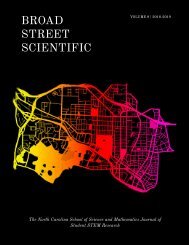Broad Street Scientific Journal 2020
You also want an ePaper? Increase the reach of your titles
YUMPU automatically turns print PDFs into web optimized ePapers that Google loves.
is then oxidized. This oxidation peak, one of the shoulder
peaks, is noticeable in the next scan. This occurs around
0.4V. Additionally, after the shoulder peak appears, the
shape remains the same upon repeated scans, indicating a
continued and predictable electrochemical response. Under
argon saturated conditions, the voltammograms appear
similar. Additionally, when the sample was purged
with argon and then saturated with carbon dioxide, the
voltammogram shape remains consistent. Past a potential
of 1V, the aqueous solution begins to oxidize, thus the pertinent
data remain between -1V and 1V on the voltammogram.
a)
The redox mechanism of sesamol was next examined
in a solution of sodium bicarbonate instead of acetic acid
(Fig. 5). The sodium bicarbonate solution yields a much
higher pH (9.52 instead of 2.49), which could be important
to consider in the mechanism of sesamol oxidation, as it is
assumed that both protons and electrons are transferred.
There is less peak definition in the sodium bicarbonate;
however, despite this, shoulder peaks can still be observed,
albeit at slightly different potentials. Here, the irreversible
oxidation step likely occurs between 0.3V and 0.4V, and
the shoulder peak first appears around 0.1V. There is the
slight appearance of a reduction peak around -0.4V which
corresponds to the reduction of the 2-HMBQ. Under argon
and carbon dioxide conditions, the general shape of
the voltammogram is retained.
3.2 – Half Cell Liquid Phase Testing
Half-cell liquid phase testing was performed on samples
of hydroquinone and sesamol (Fig. 6). When potentials
were applied, the current was measured and the sample
b)
a) b)
100mM hydroquinone
solvent
saturated
with carbon
dioxide?
0.5 M no no
NaHCO 3
0.5 M yes yes
NaHCO 3
gas
evolved?
0.5 M no no
Na 2
SO 4
c)
Figure 5. Cyclic voltammograms of 1mM sesamol in
.5M sodium bicarbonate with (a) no gas saturation,
(b) argon gas saturation, and (c) carbon dioxide gas
saturation.
0.5 M yes no
Na 2
SO 4
c) d)
100mM sesamol
solvent
saturated
with carbon
dioxide?
0.5 M no no
NaHCO 3
0.5 M yes yes
NaHCO 3
0.5 M no no
Na 2
SO 4
0.5 M yes no
Na 2
SO 4
gas
evolved?
Figure 6. Data compiled from half-cell testing on (a)
100mM 2,6-DMHQ and (c) 100mM sesamol. Photograph
of carbon paper electrode after half-cell testing
was performed on (b) 2,6-DMHQ and (d) sesamol,
showing gas evolution.
36 | 2019-2020 | Broad Street Scientific CHEMISTRY




